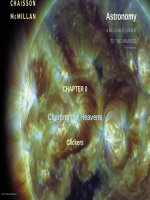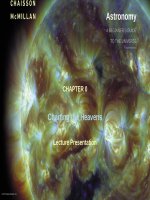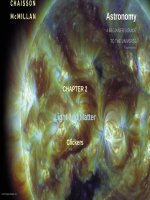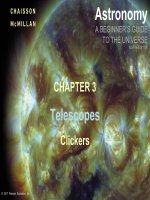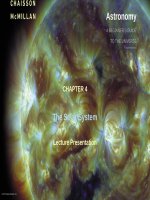Astronomy a beginners guide to the universe 8th CHaisson mcmillan chapter 10 clicker questions
Bạn đang xem bản rút gọn của tài liệu. Xem và tải ngay bản đầy đủ của tài liệu tại đây (1.44 MB, 33 trang )
Astronomy
A BEGINNER’S GUIDE
TO THE UNIVERSE
EIGHTH EDITION
CHAPTER 10
Measuring the Stars
Clickers
© 2017 Pearson Education, Inc.
Question 1
Stellar parallax is used to measure the
a)
b)
c)
d)
e)
© 2017 Pearson Education, Inc.
sizes of stars.
distances of stars.
temperatures of stars.
radial velocity of stars.
brightness of stars.
Question 1
Stellar parallax is used to measure the
a)
b)
c)
d)
e)
sizes of stars.
distances of stars.
temperatures of stars.
radial velocity of stars.
brightness of stars.
Explanation: Parallax can be used to
measure distances to stars accurately
to about 200 parsecs (650 light-years).
© 2017 Pearson Education, Inc.
Question 2
The angle of stellar parallax for a star gets larger as the
a)
b)
c)
d)
e)
© 2017 Pearson Education, Inc.
distance to the star increases.
size of the star increases.
size of the telescope increases.
length of the baseline increases.
wavelength of light increases.
Question 2
The angle of stellar parallax for a star gets larger as the
a)
b)
c)
d)
e)
distance to the star increases.
size of the star increases.
size of the telescope increases.
length of the baseline increases.
wavelength of light increases.
Explanation: Astronomers typically make
observations of nearby stars 6 months
apart, making the baseline distance
equal to 2 AU (astronomical units).
© 2017 Pearson Education, Inc.
Question 3
You can best model the size and distance relationship of our Sun and the next nearest star using
a)
b)
c)
d)
e)
© 2017 Pearson Education, Inc.
one tennis ball here and one on the Moon.
two beach balls separated by 100 city blocks.
two grains of sand 100 light-years apart.
two golf balls 100 km apart.
two baseballs 100 yards apart.
Question 3
You can best model the size and distance relationship of our Sun and the next nearest star using
a)
one tennis ball here and one
on the Moon.
b)
two beach balls separated
by 100 city blocks.
c)
two grains of sand 100
light-years apart.
d)
e)
two golf balls 100 km apart.
two baseballs 100 yards apart.
Explanation: The Sun is about 1 million miles in diameter. The next nearest star is about 25 million times farther
away.
© 2017 Pearson Education, Inc.
Question 4
A star’s proper motion is its
a)
b)
true motion in space.
apparent shift as we view from
opposite sides of Earth’s orbit
every 6 months.
c)
annual apparent motion
across the sky.
d)
motion toward or away from
us, revealed by Doppler shifts.
e)
© 2017 Pearson Education, Inc.
orbital motion around the Galaxy.
Question 4
A star’s proper motion is its
a)
b)
true motion in space.
apparent shift as we view from
opposite sides of Earth’s orbit
every 6 months.
c)
annual apparent motion
across the sky.
d)
motion toward or away from
us, revealed by Doppler shifts.
e)
orbital motion around the Galaxy.
Explanation: A star’s “real space motion” combines its apparent proper motion with its radial motion toward or away
from Earth.
© 2017 Pearson Education, Inc.
Question 5
In the stellar magnitude system invented by Hipparchus, a smaller magnitude indicates a _____ star.
a)
b)
c)
d)
e)
© 2017 Pearson Education, Inc.
brighter
hotter
cooler
fainter
more distant
Question 5
In the stellar magnitude system invented by Hipparchus, a smaller magnitude indicates a _____ star.
a)
b)
c)
d)
e)
© 2017 Pearson Education, Inc.
brighter
hotter
cooler
fainter
more distant
Question 6
A star’s apparent magnitude is a number used to describe how our eyes measure its
a)
b)
c)
d)
e)
© 2017 Pearson Education, Inc.
distance.
temperature.
brightness.
absolute luminosity.
radial velocity.
Question 6
A star’s apparent magnitude is a number used to describe how our eyes measure its
a)
b)
c)
d)
e)
© 2017 Pearson Education, Inc.
distance.
temperature.
brightness.
absolute luminosity.
radial velocity.
Question 7
The absolute magnitude of a star is its brightness as seen from a distance of
a)
b)
c)
d)
e)
© 2017 Pearson Education, Inc.
1 million kilometers.
1 astronomical unit.
1 light-year.
10 parsecs.
10 light-years.
Question 7
The absolute magnitude of a star is its brightness as seen from a distance of
a)
b)
c)
d)
e)
1 million kilometers.
1 astronomical unit.
1 light-year.
10 parsecs.
10 light-years.
Explanation: Astronomers use
a distance of 10 parsecs
(about 32 light-years) as a
standard for specifying and
comparing the brightnesses of stars.
© 2017 Pearson Education, Inc.
Question 8
Which of the following quantities do you need in order to calculate a star’s luminosity?
a)
b)
c)
d)
e)
© 2017 Pearson Education, Inc.
Apparent brightness (flux)
Doppler shift of spectral lines
Color of the star
Distance to the star
Both a and d are correct.
Question 8
Which of the following quantities do you need in order to calculate a star’s luminosity?
a)
b)
c)
d)
e)
© 2017 Pearson Education, Inc.
Apparent brightness (flux)
Doppler shift of spectral lines
Color of the star
Distance to the star
Both a and d are correct.
Question 9
What are the two most important intrinsic properties
for classifying stars?
a)
b)
c)
d)
e)
© 2017 Pearson Education, Inc.
Distance and surface temperature
Luminosity and surface temperature
Distance and luminosity
Mass and age
Distance and color
Question 9
What are the two most important intrinsic properties
for classifying stars?
a)
Distance and surface
temperature
b)
Luminosity and surface
temperature
c)
d)
e)
Distance and luminosity
Mass and age
Distance and color
Explanation: The H–R diagram plots
stars based on their luminosities and
surface temperatures.
© 2017 Pearson Education, Inc.
Question 10
Wien’s law tells us that the hotter an object, the _____ the peak wavelength of its emitted light.
a)
b)
c)
d)
e)
© 2017 Pearson Education, Inc.
longer
more green
heavier
shorter
more constant
Question 10
Wien’s law tells us that the hotter an object, the _____ the peak wavelength of its emitted light.
a)
b)
c)
d)
e)
longer
more green
heavier
shorter
more constant
Explanation: Wien’s law
states that hotter stars
appear more blue in color,
and cooler stars appear
more red in color.
© 2017 Pearson Education, Inc.
Question 11
We estimate the surface temperature of a star by using
a)
b)
its color.
the pattern of absorption
lines in its spectrum.
c)
d)
Wien’s law.
differences in brightness
as measured through
red and blue filters.
e)
© 2017 Pearson Education, Inc.
All of the above are used.
Question 11
We estimate the surface temperature of a star by using
a)
b)
its color.
the pattern of absorption
lines in its spectrum.
c)
d)
Wien’s law.
differences in brightness
as measured through
red and blue filters.
e)
© 2017 Pearson Education, Inc.
All of the above are used.
Question 12
Which spectral classification type corresponds to a star like the Sun?
a)
b)
c)
d)
e)
© 2017 Pearson Education, Inc.
O
A
F
G
M
Question 12
Which spectral classification type corresponds to a star like the Sun?
a)
b)
c)
d)
e)
O
A
F
G
M
Explanation: The OBAFGKM
classification scheme is based
on absorption lines.
© 2017 Pearson Education, Inc.
